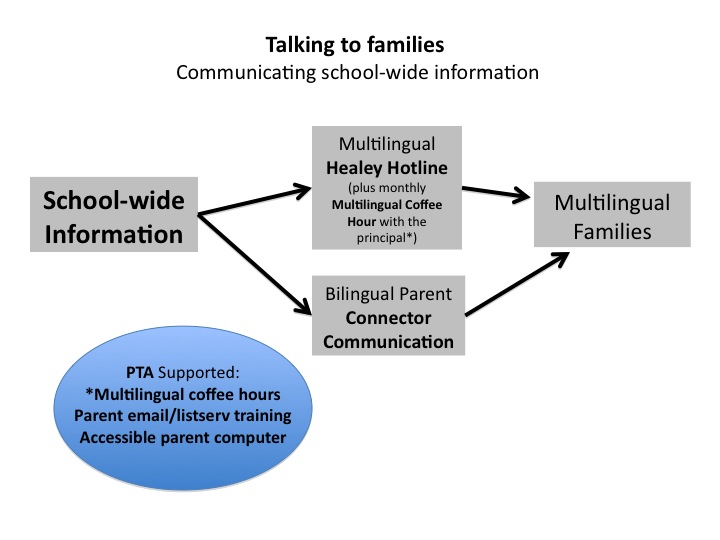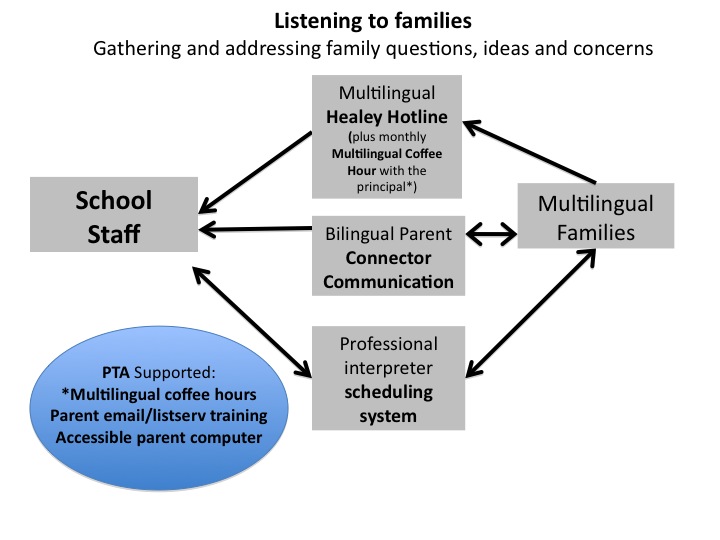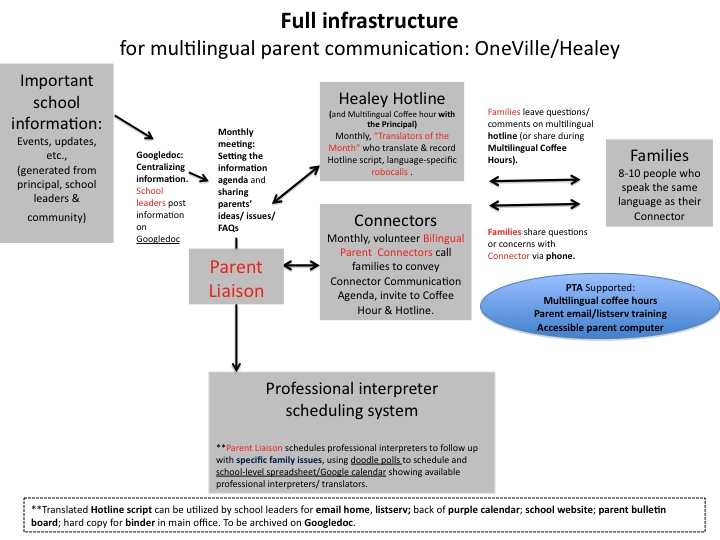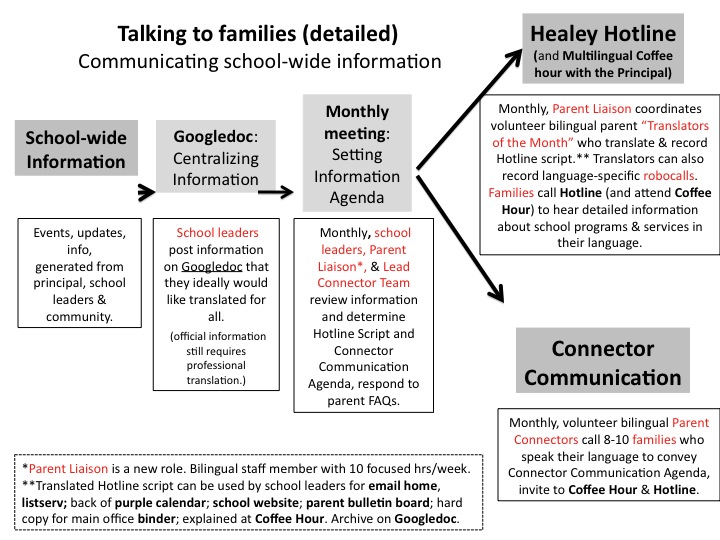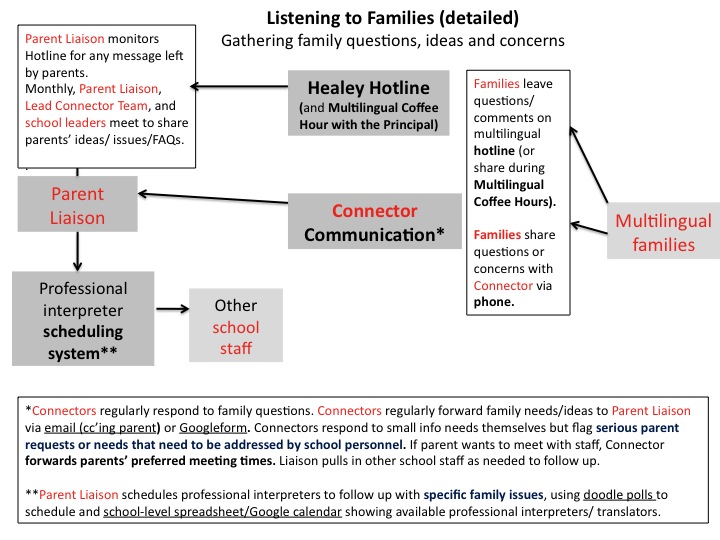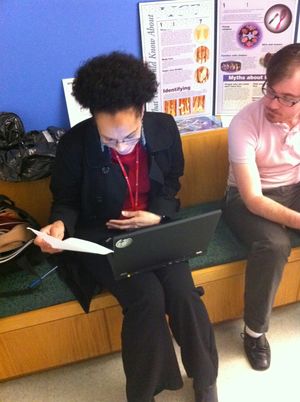Overview and key findings: Schoolwide toolkit/parent connector network
From Oneville Wiki
Written by Mica Pollock, Tona Delmonico, Gina d'Haiti, and Ana Maria Nieto for the Parent Connector project, with input from parents across the Healey School
As we documented this project, we thought about OneVille's project-wide questions:
Who needs to communicate what info to whom, through which media, in order to support young people?
Which barriers are in the way of such communication, and how might these barriers be overcome?
How might basic tech help increase community cooperation in young people’s success, by supporting diverse students, teachers, parents, administrators, service providers, and other community members to share ideas, resources, and information and to build relationships?
Summary
(A bird’s eye view for the quick reader. We're addressing these questions:)
a. What communication did we hope to improve, change, or create? Why?
b. Main efforts, and concrete communication improvement(s). (Who was involved in the project and how was time together spent? What did the project accomplish? How did communication improve? What new support for young people may have become more possible?)
c. Main realizations. (At this point, what's our main realization about improving communications in public education? (We'll say a few overall words in response to OneVille's research questions, above!)
The Parent Connector Network was the 2010-11 focus of an overall Working Group exploring Schoolwide Communication at the K-8 Healey School in Somerville. In this Working Group, parents and staff have been figuring out how to ensure that all parents in a multilingual and socially diverse school can access important school information and share ideas with other parents and school staff.
Over the course of two years, we met parents particularly committed to improving schoolwide communication and linked them in to the effort.
In the past year, we particularly paid attention to including immigrant parents in this loop of school information and input. We focused on creating a "Parent Connector Network," in which bilingual volunteer parents ("Connectors") use phones, Googleforms and a phone-messaging hotline to help get information to and from immigrant parents who speak their language.
Begun in Winter 2011, the Parent Connector Network is a parent-led effort (in partnership with school administrators and staff) to support translation and parent-school relationships, by connecting bilingual parents (“Connectors”) to more recently immigrated parents via a phone tree. The Connectors have come to also use Google forms to gather school information, Google spreadsheets to track calls with parents, and a multilingual hotline we made using free software, to help ensure that information reaches immigrant and low-income families who share the school.
We are currently working with 3 Spanish-speaking, 3 Portuguese-speaking, and 2 Haitian Creole-speaking Parent Connectors. Each Connector is asked to call approximately 10 other families once a month to share key information from the principal/school and to ask questions about any issues parents are facing. The Connectors are also on-call to these parents during the school year to help them find answers to both general and specific questions or concerns they may have about their child’s school. (one Connector even got calls this summer -- about summer school enrollment and about how to reach the district’s Parent Information Center to enroll a new cousin in a school.) We also argued for creating a part-time liaison role for one staff Connector so that she can help with a key structural issue: scheduling interpreters.
This past year the Connectors have also become key innovators of school-wide translation and interpretation infrastructure. Over the 2010-11 school year, we've been fleshing out a list of such systemic supports, which we’ve diagrammed completely here.
The Parent Connector Network is a key component, but it's not the only one! We’ve also made a video of our model here, which we'll continue to test and tweak in fall 2011.
Here's one MAIN COMMUNICATION REALIZATION from the Parent Connector Network. In a multilingual school and district, improving translation and interpretation -- and strengthening relationships between families and educators -- requires getting more organized about effectively tapping a key local resource: bilingualism.
Now, let's expand on each aspect of the project. Here we go!
Communication we hoped to improve
A bit more. What aspect of existing communication did we hope to improve, so that more people in Somerville could collaborate in young people's success?
At Somerville’s Healey School (K-8), as in many U.S. schools, parents hail from across the globe and speak many languages. Language barriers keep parents from being equally informed about school issues, events, and even educational opportunities. So do disparities in tech access, tech training, and time -- as well as gaps in personal relationship and connections.
The Healey School enrolls a full U.S. range of families with different communication habits and needs. Some email the principal and Superintendent regularly. Some parents have no computers and no internet. A listserv has long enrolled only some. Robocalls home go in four languages; handouts home often don't. For many, parent teacher conferences require interpreters, and scheduling those interpreters itself is a structural communication problem. One Portuguese-speaking dad worked such long hours he didn't even have time to come to school to post a sign saying he wanted to find and pay another parent to help him drive his daughter to school. (His "Connector" made the sign for him.) One Spanish-speaking parent told her Connector she’d been trying for a year to meet with her child’s teacher. In contrast, some families, particularly English-speaking families, volunteer many hours in classrooms during the school day and so get regular access to their child’s teacher; many such families also sat on committees that met after school and so, took the opportunity to contribute ideas to the school. Parents who saw each other regularly at face to face school events also made friends, joined listservs, signed up in directories, and showed up at next events.
Everyone at the Healey talked about needing better school-home and parent-parent communication, particularly to fully include immigrant families, families without computer access/knowledge, and families who couldn’t or didn’t show up often in person at the school.
Throughout the schoolwide communication working group, we operated from a central principle already core to the Healey School: a child can’t be educated as effectively if parents aren’t included as key partners in the project. So, schools should ensure access to school information and pull all parents into dialogue about improving their children’s school experience. Info out, input in!
Because language barriers particularly have excluded Healey parents from full participation, the Parent Connector Network has focused on reaching out to parents who speak the district's 3 main languages other than English: Spanish, Portuguese, and Haitian Creole. We've also been working to build personal relationships between bilingual parents and recent immigrant parents in order to bring more voices into school debates and more people into school events and leadership, as well as help the school respond more quickly to parent needs.
Because each innovation the Connectors started needed other components to work effectively, we have come to think in terms of creating an "infrastructure" for multilingual communication (and low-cost translation and interpretation) in a school.
Process: How did the project change and grow over time?
How we realized and redirected things. Two sections, one short and the second long:
Basic History
The groundwork needed to support the current work.
As a multilingual group of parents and staff (a few of whom speak only English), it has taken us two years to fully understand:
- 1) the barriers in the way of English learners' participation in English-dominant schools;
- 2) the sort of systemic communication "infrastructure" necessary to include more immigrant parents as partners in the project of supporting young people.
Before we started working on the Parent Connector Network in Winter 2011, we worked with families and teachers in other efforts to improve parent-school and parent-parent connections. Work informing the Parent Connector Network began in a 2009-10 series of Reading Nights and Parent Dialogues, and a Multilingual Coffee Hour that continued in 2010-11. (We tell the full story in the next section! See Parent connector network/ahas!)
Most of all, we had to make friends with other parents and staff who cared deeply about including everyone. These friends became key partners in innovation!
Communication ahas, implementation ahas, and turning points!
Over the course of the project, we had the following communication and implementation ahas, and project turning points. An “aha” refers to the moments when we said “Aha! we’ve figured out something really helpful!” Or, “Aha! Now we understand!” “Turning points” refer to moments when we used these ahas to make changes to our work. To read the full accounting (our main documentation of this project!), see main article: Parent connector network/ahas
Findings/Endpoints
Here's where we describe final outcomes and share examples of final products, with discussion! Three sections below:
Concrete communication improvements
What is the main communication improvement we made? What new support for young people may have resulted?
We are proud to say that the Parent Connector vision and project is now part of the Healey School's school site plan. We have a core of volunteer Connectors making calls and ready for fall, lead Connectors in each language, and two current/former HGSE graduate students working to support the effort while it solidifies. The new principal has agreed that one of our Connectors, Gina, already a young Creole-speaking staff member, will be supported by the school 10 hrs/week as a part-time parent liaison to handle parent needs forwarded by the Connectors and to oversee the multilingual communication process we’ve come up with here.
We are finishing our hotline this summer so that Translators of the Month can easily upload updates this fall. We’re honing a Googledoc where school leaders put schoolwide information for Translators to translate on to the hotline. We’re also creating a Googledoc of basic contact info/citywide parent services info all Connectors need to know. We’ve helped to draft fall “Parent Communication form” that will help parents sign up to get a Connector and make it easier to get parents’ phone numbers link to final form!. We’re also teaming up with PTA leaders, who will begin to offer email/listserv training to parents this fall to address this key barrier to schoolwide communication.
Main communication realizations and implementation realizations
At this point, what are our main realizations about improving communications in public education? (Here are our main thoughts on OneVille’s research questions.)
What big changes would we recommend re. improving the “communication infrastructure” of public education, so that more people can collaborate in student success?)
What’s the main thing we’d recommend to other communities or schools implementing similar innovations? (What would we expand or do differently were we to do this again?)
Communication from school to home and back again is a huge issue in any diverse school, particularly across boundaries of language and tech access/training.
MAIN COMMUNICATION REALIZATION: Along with strong intentions to include all families, diverse schools need systems -- infrastructure -- for getting information to everyone and input from everyone. If structures don’t exist to get info out and input in, information just doesn’t get translated, distributed, or shared despite good intentions. And parent-school partnerships that could happen, don’t.
Today, systems for getting information to all families and input from all families can absolutely be improved using some very basic technology – as long as the tech is basic and parents and staff are shown how to use it. In multilingual schools, people also need to organize to tap a key local resource: bilingualism. Such structural improvements can help include everyone and send the message that everyone is to be included.
MAIN IMPLEMENTATION REALIZATION: Overall, we’ve learned that committed and diverse parents can be expert innovators of communication infrastructure for including all parents because they have a full understanding of communication barriers. (In fact, we've learned that nothing can stop a creative group of committed parents!)
Together, the Connectors (with advice from many other parents and staff consulted over the two years) fleshed out a list of components of the necessary “infrastructure” for multilingual communication. The Connectors themselves are a key local resource, as people willing to be on call to answer other parents' questions in their language and to (monthly) share information that requires more explanation.
MAIN IMPLEMENTATION REALIZATION: The people who share a school can, will, and should volunteer their time to help the school and other families communicate. But only up to a certain point.
In the Schoolwide Communication project in general, we repeatedly hit up against a core issue: how much time will parents volunteer to support connections between families, and between families and school? Schools can’t rely upon volunteers too much.
A key issue we addressed in the Parent Connector Project was the line between translation/interpretation that bilingual parents can and will do as volunteers to serve their community, and when the district has to pay professionals. A parent in a federally funded district has a civil right to translation and interpretation if she needs it to access important parent information (including at parent-teacher conferences). But all districts are strapped for money and bilingual skills are true community resources. How to tap those resources without overtaxing volunteers, and without asking volunteers to do the sort of work that really should be done by paid professionals? We’ve been exploring a cost-effective hybrid of volunteer efforts to connect parents to other parents (in ways that also help unite the school), and “infrastructure” that includes paid school staff.
In particular, our final aha of the year was that communication on individual parents’ serious personal needs may have to be covered by paid staff, freeing volunteers to be friends, info-sharers and people linking other parents TO paid staff. Volunteers shouldn't be asked to ensure that parents get Special Education services for their kids or legal assistance for their families. But volunteers may be able to do something no staff member can do so easily: build friendships that glue people together as partners in student success.
MAIN COMMUNICATION REALIZATION: One of our Connectors had an AHA that others echoed across the OneVille Project: “My main conclusion is that relationships matter and they are what makes everything work.”
Next Steps
What do we plan to do next?
Our next step this fall is to to pilot the full infrastructure we’ve developed for multilingual communication, while adding in a next piece: PTA-run parent email/listserv training. We plan to:
- a) pilot our open source hotline, to support bilingual parent “Translators of the Month” to translate information about events, issues, and opportunities;
- b) finish testing our Parent Connector Network, in which bilingual parents use phones, Google forms, and the open source hotline to help get information to and input from immigrant and low-income families;
- c) help create a sustainable model where the PTA trains parents to get Gmail accounts, use a school listserv, and use Google Translate to translate listserv information.
Technological how-tos
Here's where we describe "how to" use every tool we used, so that others could do the same. We also describe "how to" make every tool we made!
We’re using a Googledoc as one organized place where the principal and school leaders put info that most needs translation each month. (Note: to use googledocs, users sometimes have to get gmail accounts. http://translate.google.com/support/ (Or, for immigrant parents, should we make a video and narrate?)
We use Google spreadsheets for lists of approved parent numbers. And, to keep things simple, we now use the same spreadsheets for Connectors to record parents’ needs after they make calls home.
As a group of non-technologists, we had to learn how to set up Googlespreadsheets. See our short VIDEO TALKING THROUGH THESE? Or, link to Google instructions? COULD ANA AND GINA MAKE THIS?
We’ve experimented with robocalls home, using Connect-Ed, the district’s existing system for school-home calls. Here’s an instruction sheet from Somerville’s Parent Information Center explaining to administrators how to use Connect-Ed: Regina’s sheet here??.
In our case, we targeted robocalls to one language group at a time instead of recording all four at once, because robocalls often cut off after the first two languages (and because Portuguese and Haitian Creole were always last!). We also asked Connectors to record some robocalls in their friendly parent voices, which drew some parents to PTA night!
Hotline setup was a task for Seth. In April, we were still sitting at Seth’s computer talking into it -- see photo! Or, those of us with Audacity on our computers could record from home and send Seth the files. Over the summer, we xxxxx. SETH ADD HERE AND MAKE A VIDEO EXPLAINING HOW TO DO THE HOTLINE?
Questions to Ask Yourself if You’re Tackling Similar Things Where You Live
If you wanted to replicate any of this, what would you need to think about? Contact us to learn/talk more!
Consider the current and needed schoolwide communication infrastructure at your school:
- -Where do you put school information and parent ideas so that everyone in the school can see them?
- -Can everyone who needs to get and share important school information, get and share it? If not, what barriers are in the way and how can those be overcome?
- -What infrastructure do you have for translation and interpretation, in particular?
- -How can local bilingualism be treated as a key resource in connecting people to each other and to information?
- -How can you organize volunteers to pitch in on translation and interpretation in a way that doesn't take too much of their time?
- -How can you build on parent-parent relationships to pull all parents into school events and conversation? Would a Connector-like project work at your school?
- -What tech training do parents need in order to get information? How could you help all parents get this training?
- -What tech training do volunteers need? What relationships do they need to form with each other so the work is personally rewarding?
- -Which efforts at parent information should be a task for school staff rather than volunteers? (In our case, we mapped out a system for multilingual communication in the school and then argued for one of our Connectors to be made a staff liaison/Lead Connector for 10 hrs/week to run the parts of it volunteers couldn’t run.)
